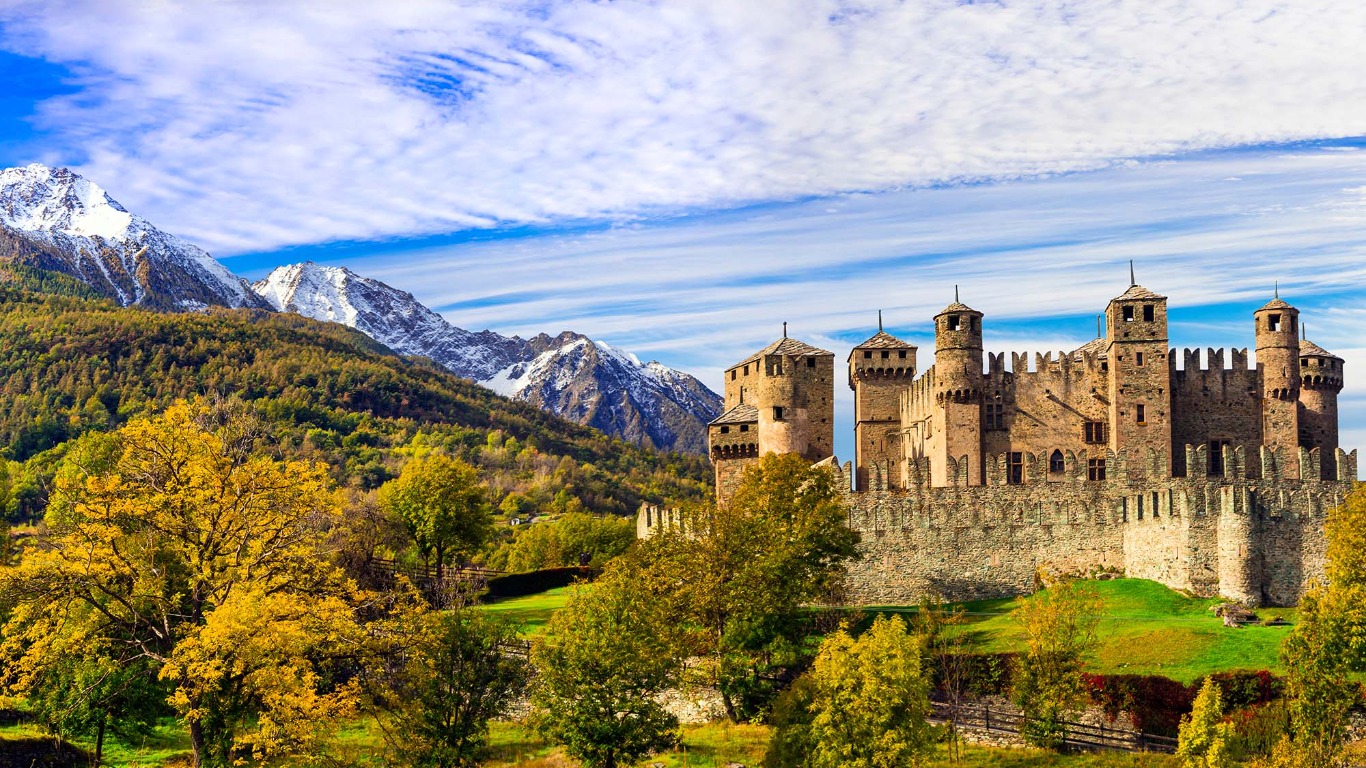Explore the Aosta Valley: what to see, where to stay and what to eat
The Aosta Valley is a hidden part of Italy that few people visit but with castles, Roman ruins, alpine lakes, glaciers, breathtaking mountain landscapes and fabulous food, there is much to discover.
Why go to Aosta Valley?
The lush Aosta Valley, or Valle d'Aosta, stretches between majestic mountain ranges in northwestern Italy with the snow-capped peaks of Mont Blanc, Monte Rosa, Matterhorn and Grand Paradiso dominating the horizon. In the countryside, a wealth of medieval castles and fortresses dot the landscape and the region's famous cheese, fontina, takes centre stage in many local recipes.
Aosta has been at the crossroads of French, Swiss and Italian influences for over 2,000 years and all the unusual place names tell a story. Italy's smallest region, Aosta Valley is autonomous and bilingual with French as a second official language – locals learn both but speak the patois of their village.
Here's why this underrated region is perfect for your next outdoor escape.
The best things to do in Aosta Valley
Enjoy outdoor adventures on the mountains
Aosta Valley's mountains are a big draw for outdoor adventurers in any season. The region is a summer favourite for hikers, mountain bikers and climbers, while winter brings a wealth of powdery pistes to glide down.
La Thuile in Valdigne, at the top of the valley, is the perfect base for exploring the landscape. There are many hiking and biking routes that take you up to stunning mountain lakes, waterfalls and 94 miles (151km) of slopes. The best hike here is from La Joux, a two-hour trek up to the three Rutor glacier waterfalls. If you reach the bridge of the top waterfall at 11am, you can capture the rainbow over the falls as the sun moves into position. The well-marked routes are open year-round and you can do this without a guide.
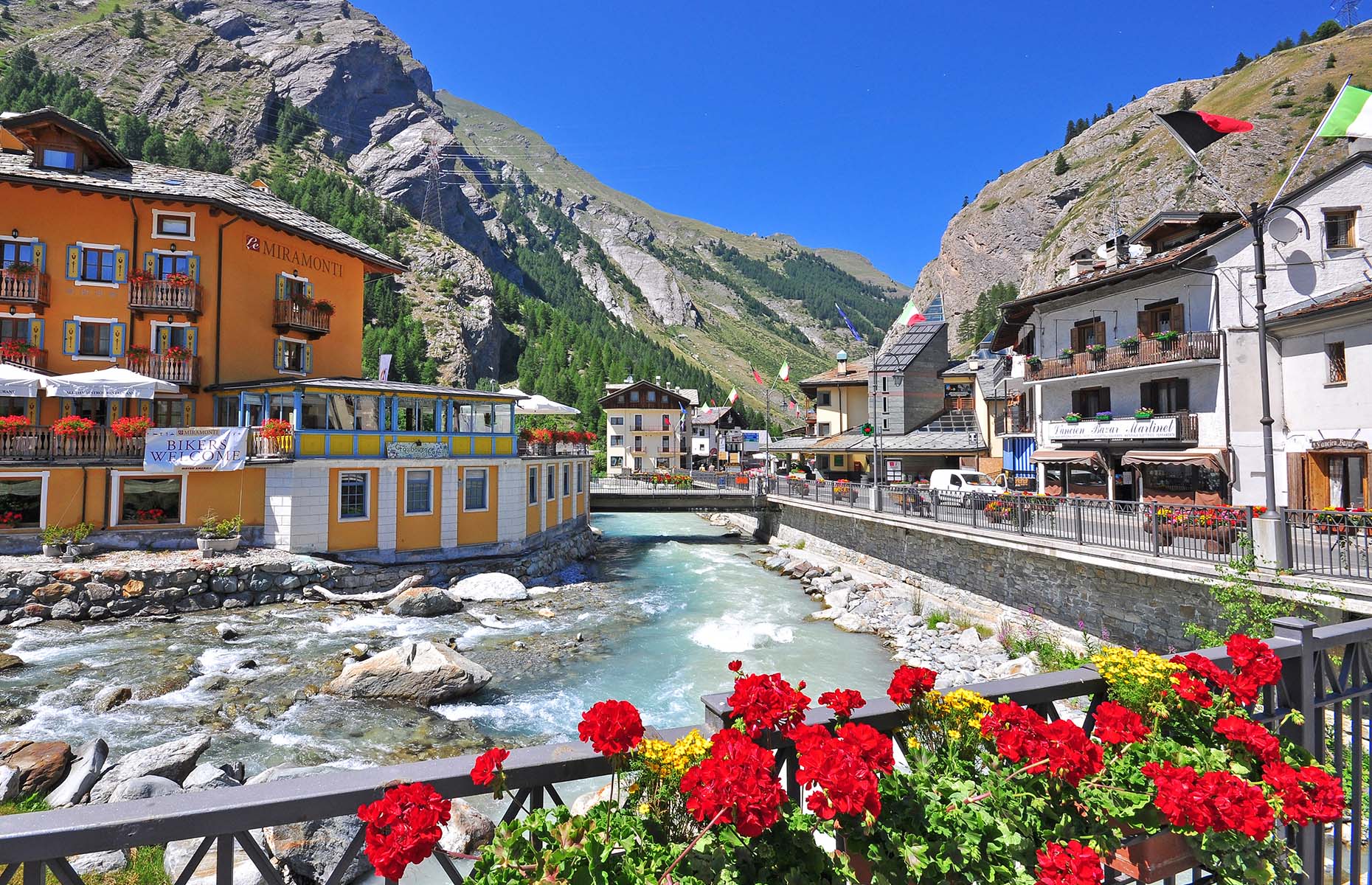 Arsenie Krasnevsky/Shutterstock
Arsenie Krasnevsky/Shutterstock
If you don't fancy hiking, you can take an e-bike tour that takes you up to Lake Arpy, one of the many mountain lakes fed by the Rutor glacier. The terrain is rocky and sometimes narrow and steep, but even beginners can get there on an e-bike. For mountain bikers, the MTB Natural Trail Area starts at 8,500 feet (2,600m), with routes that suit beginners to highly technical cyclists. You can book e-bike or mountain bike guides via the local MTB office in La Thuile.
After a day of adventure, take a wellness break at the QC Terme Pré-Saint-Didier spa. Soak away aching muscles in the outdoor thermal pools with panoramic views of Mont Blanc. Indulge in thalassotherapy, outdoor saunas and happy hour in the bistro.
Soar high above the valley with Skyway Monte Bianco
Courmayeur is better known as the biggest ski resort in Italy. In the summer, it is the host of many events like the Tor des Géants endurance race, but it's biggest attraction is the unmissable Skyway Monte Bianco. Not your regular cable car, Skyway is a circular cable car that rotates 360 degrees as it ascends so you get a great view wherever you stand.
Make a stop at the middle station (Pavillion The Mountain) to discover the Cave Mont Blanc cellar. They make a fine Spumante (Champagne-method sparkling wine) here as the altitude creates tiny bubbles. You can arrange for a private tasting and 'pielotage' where they open the bottles with an ice axe. Engineering buffs will love the old cable cars preserved in the Hangar 2173 museum. Then, marvel at the early paintings of Mont Blanc and see how much the glacier has receded before heading up to the final stop, Punta Helbronner The Sky.
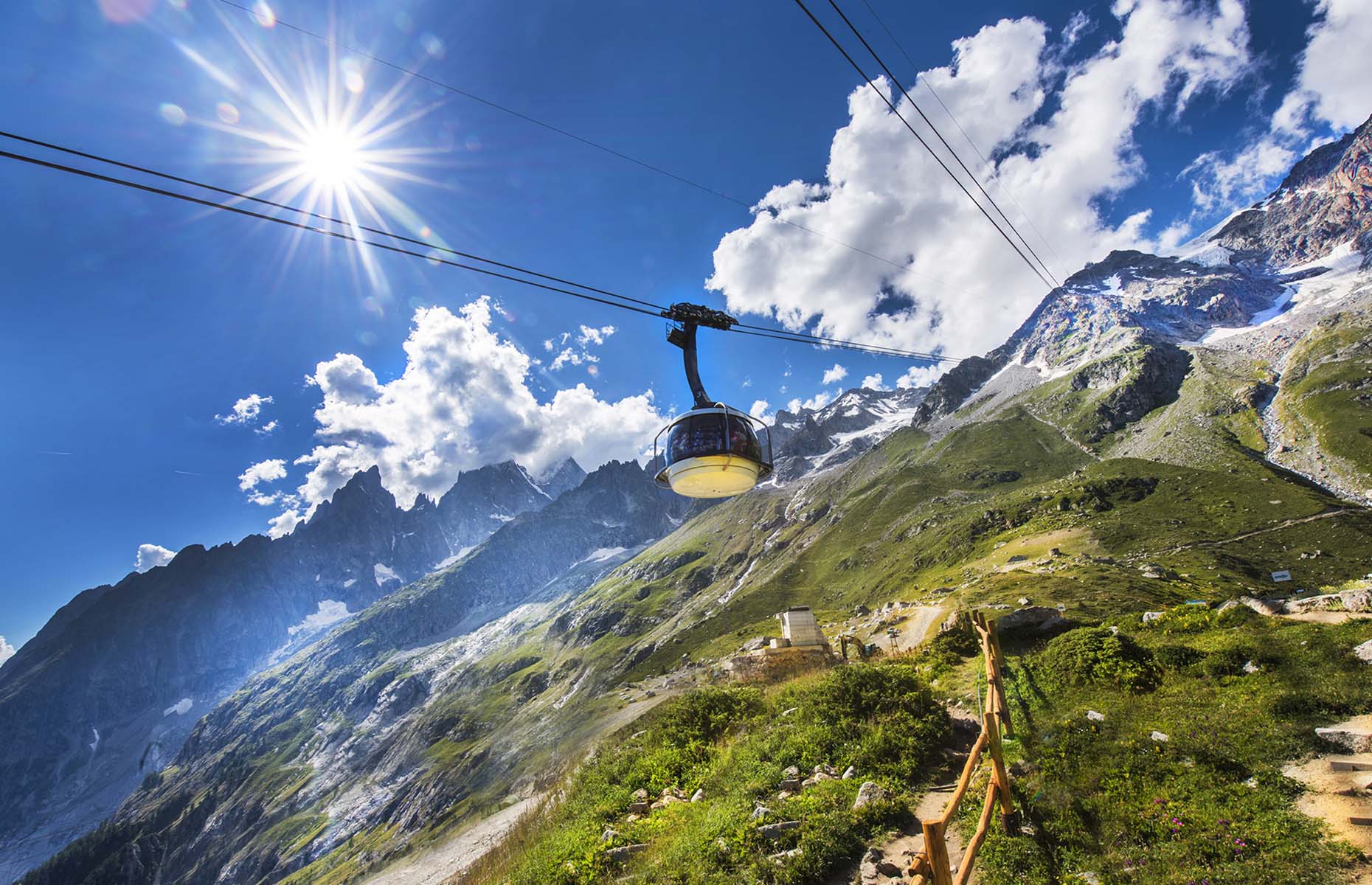 Mirko_88/Shutterstock
Mirko_88/Shutterstock
At the top, just over 11,000 feet (3,466m) above sea level, you get a 360-degree view of all the peaks and snowy Mont Blanc. When the weather is right, you can take a guided walk across the glacier. Dress in layers as it can get very cold. When you're ready to head back inside, dine at the infinity table by Kartell. Designed to be a glass cube projecting into the void, the culinary experience is curated by Michelin-starred chef Paolo Griffa and focuses on local, Alpine cuisine. For something a little more low-key, stop for a drink on the sunny terraces of historic Rifugio Torino, built in 1898 as the starting point for great mountaineers and Alpine guides.
From Punta Helbronner it's possible to cross the border into France and visit Aiguille du Midi, Plan de l'Aiguille and Chamonix via Chamonix-Mont-Blanc cable cars. Round-trip tickets for Skyway Monte Bianco (from Courmayeur to Punta Helbronner) cost from €55 (£48) for adults.
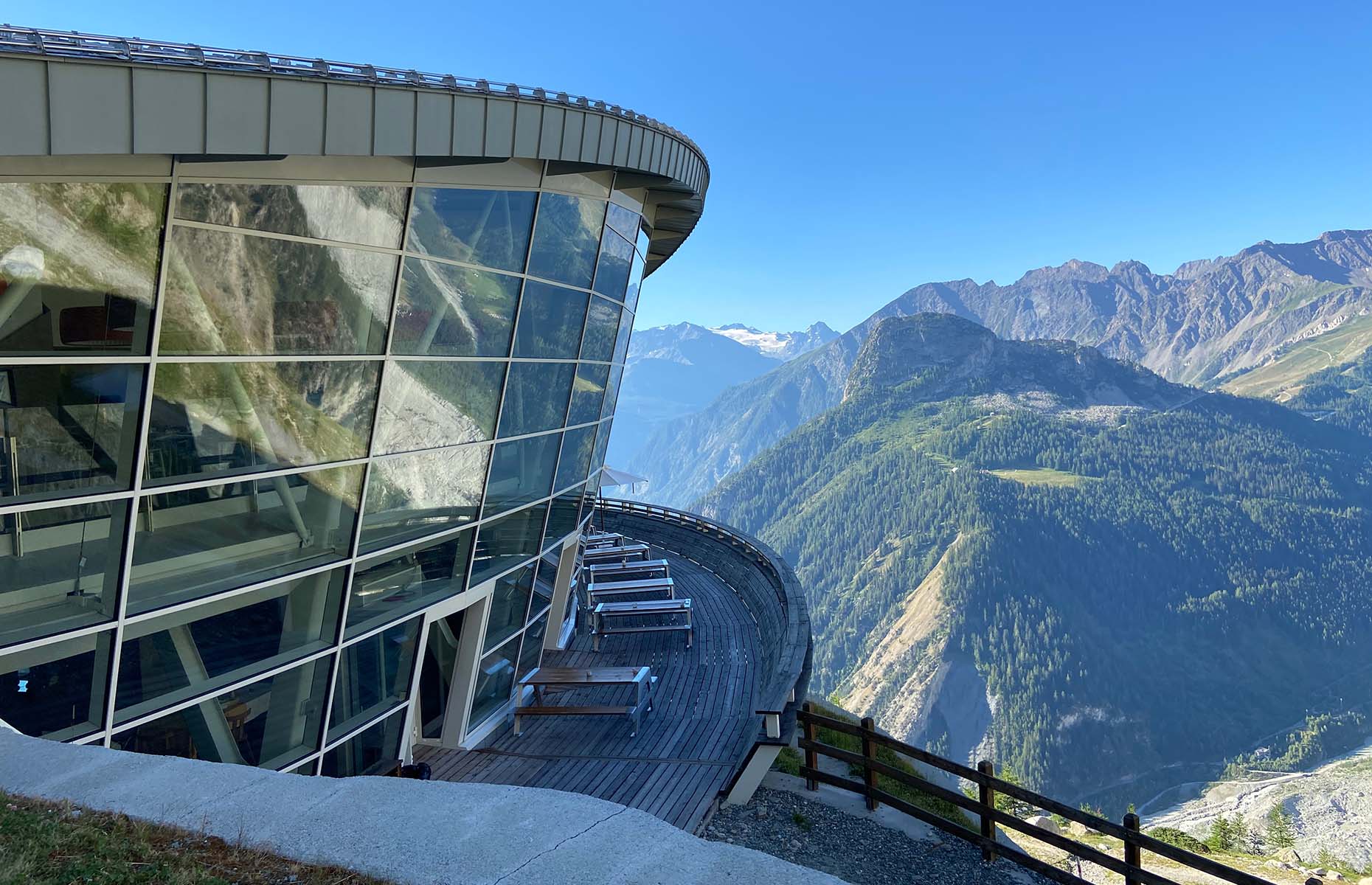 Ece Chianucci/Shutterstock
Ece Chianucci/Shutterstock
Discover Roman ruins
For a long time in history controlling the Grand and Little Saint Bernard passes was key as these were the only routes connecting Italy with the rest of Europe on the other side of the Alps so it's little surprise a Roman settlement was founded here. Aosta town was built around the ruins of what was once known as Augusta Praetoria and now serves as the capital of the region.
From the ruins of the Roman bridge to the imposing theatre, there's little doubt Aosta played an important part in the empire. Today, the intact cryptoporticus is what attracts archaeologists and history fans to travel from afar to Aosta. It's a mystery what it was for but it's thought it could have been the basement for the forum and temples above ground.
There are many more layers to the town so it's well worth setting aside a day to discover the diverse architecture and history of Aosta.
 Alxcrs/Shutterstock
Alxcrs/Shutterstock
Play a king or queen for the day in Aosta's castles
As you travel through the enchanting landscapes of the Aosta Valley along the road north from Turin, you'll see some of the 120 medieval castles that dot the region. These were built for a variety of purposes, from communication to defence, and today 25 are open as museums.
Sarre Castle, built in 1710, tells the story of the House of Savoy in the valley and their hunting expeditions here; Issogne Castle belonged to the Challant family and is worth a stop thanks to its stunning frescoes depicting daily life in medieval times, including one on cheesemaking, possibly the earliest record of fontina cheese being made.
Lower down the valley, you will find Fort Bard, an imposing military fortification built in the 1800s on the site of an old medieval castle. Today, it is a cultural centre and recently was the filming location for Marvel's The Avengers: Age of Ultron. You can access the fort via a series of funicular railways or you can walk up the steep slopes. A combined ticket allows access to the exhibitions, old prison and the Museum of the Alps.
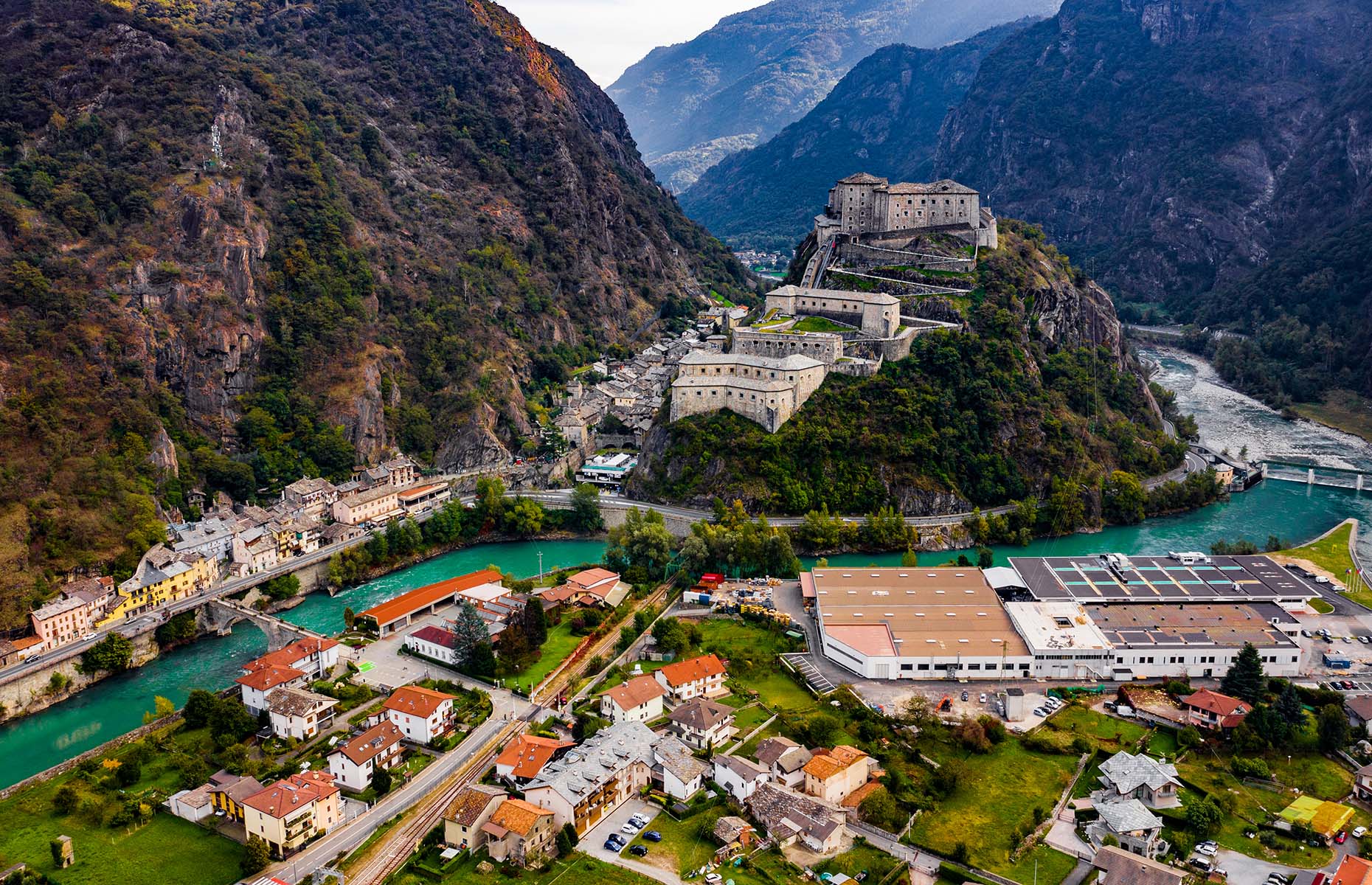 Enrico Pescantini/Shutterstock
Enrico Pescantini/Shutterstock
READ MORE: 6 reasons to visit northern Italy's Brescia
Where to stay in Aosta Valley
There are several excellent hotel options across the region for every budget and need. Hotel Montana Lodge is a modern alpine hotel in La Thuile ski town. Its spacious rooms with modern decor and the adjoining spa are very popular in the summer with hikers, bikers and locals escaping cities further south.
QC Terme is a little further down the mountain in Pré-Saint-Didier, close to Courmayeur. There is a spa in the hotel too if you can't make it to its sprawling spa complex nearby.
To explore the central area of the valley, the modern Duca D’Aosta Hotel is centrally located in Aosta so perfect for exploring the town on foot. Breakfast in the hotel's modern patisserie is quite special.
For a unique stay, book Room 31 at Rifugio Torino, on top of Mont Blanc. This charming accessible room has the best views over all the peaks of Aosta Valley.
What to eat and drink in Aosta Valley
Made in this region since the 12th century, fontina cheese DOP is an unpasteurised cow's milk cheese and arguably Aosta Valley's most famous foodstuff. The locals use it in dishes like fonduta, an Italian fondue, and cabbage and fontina soup. Regional charcuterie is also unmissable, especially the only European-certified Lard d'Arnad PDO, made from local pigs, herbs and spices.
Pair these with the local Valle d'Aosta DOC wines. All along the valley, from the foothills of Mont Blanc down to the border with Piedmont, the sunny side of the valley is planted with vineyards benefitting from the rich, glacial soil. The geography of the region also protects the vines from phylloxera (a grapevine insect pest) and it's the only one in Europe that still plants its native grape, Prié Blanc.
Further down the valley, towards the Piedmont border, red wine from Nebbiolo grapes, like Barolo, is popular. It is worth booking a wine and gastronomy tour where you can dine in the vineyards and taste all the local wines in situ.
Unmissable places to eat include the restaurant at Pavilion The Mountain (the middle stop of the Skyway cable car). Book in advance to enjoy a stylish buffet of Italian Alpine dishes in a stunning room with a view.
For regional Aosta Valley cuisine, sit down at Trattoria Praetoria in Aosta town, while Al Maniero in Issogne is a charming restaurant run by a husband-and-wife duo. Chef Giovanni is a wizard, sending out dishes like porcini flan, fonduta with fontina and the local speciality, apple pie, while his wife Manuela dresses a delicious salad with style. Booking is a must.
READ MORE: Explore Trentino with our guide
How to get there
Fly to Turin or Milan and from there it is a two-hour drive to the foothills of Mont Blanc. The best way to explore the valley is by car.
You can travel by train from Milan or Turin which takes you to Aosta in about two hours. From there, regional buses connect you with the valleys.
Map of Aosta Valley
Explore Aosta Valley with our handy map:
For more information on Aosta Valley visit aosta-valley.co.uk.
READ MORE: Why you should explore Italy's Friuli Venezia Giulia region by bike
Lead image: leoks/Shutterstock
Comments
Be the first to comment
Do you want to comment on this article? You need to be signed in for this feature
